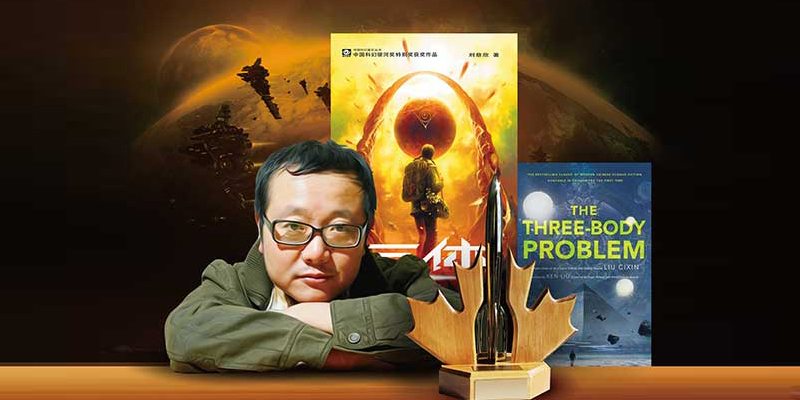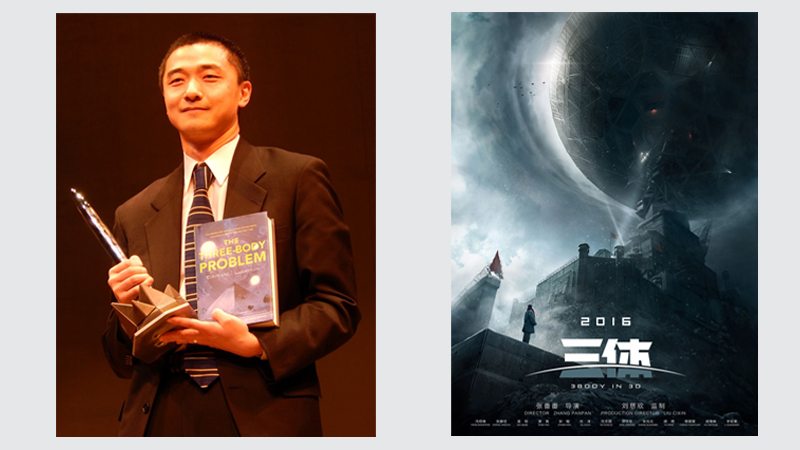
Barack Obama took the book along to read on his holiday, and on finishing said, “So that was fun to read, partly because my day-to-day problems with Congress seem fairly petty — not something to worry about. Aliens are about to invade!” Mark Zuckerberg included it in his ‘Year of Books’ reading list. Prominent SF/F authors – from George RR Martin and David Brin to Kim Stanley Robinson and Lavie Tidhar – recommend it. The New Yorker called its author “China’s answer to Arthur C. Clarke.”
“Everything that I write is a clumsy imitation of Arthur C. Clarke”, says Cixin Liu – who is perhaps more popular in China today than Clarke and Asimov. But maybe the comparison isn’t too far misplaced in spirit, for The Three-Body Problem is a grand turn in the style of the vintage novels of the Golden Age; a throwback in spirit to the space classics, which sparked many a child’s imagination. It is a welcome change at a time when most of today’s (Western/English) sci-fi novels have turned their gaze earthwards, and to exploring contemporary themes.
It’s not often – in fact, this is probably a first – that a translated novel, let alone a Chinese sci-fi novel, has won the prestigious Hugo Award for Best Novel. It has also been a nominee/finalist for other big SF/F awards like the Nebula, Prometheus, Locus, and John W. Campbell Award. And yes, the inevitable ‘movie based on’ is in the works in China.
So it is really worth all this fuss and your time? Yes.

At its heart, The Three-Body Problem is a novel of stumbling upon alien intelligence. It asks the questions that all first-contact novels do, ‘What would we do if we come in contact with an extra-terrestrial civilization, and how?’ And answers it with a uniquely enjoyable blend of science, speculation, technology, philosophy, politics, culture, conspiracies and cosmology, all rooted genuinely in a non-Western culture, which to many of us – exposed as we are primality to Western SF – may seem somewhat alien (no pun intended).
The shadow of China’s Cultural Revolution looms large over this book, providing a glimpse into China’s past history and current politics. It is in this period that the story begins, with us being introduced to one of the main protagonists, Ye Wenjie, an astrophysicist traumatised by her physicist father’s brutal execution for the unforgivable crime of teaching the ‘reactionary’ science of general relativity. Branded a reactionary herself, she soon finds herself exiled to a secretive base, a station designed to broadcast into space and listen for extra-terrestrial responses, where she will take a decision – driven by her loss of faith in humanity – that will span light years and decades and put the whole of humanity on course for an extinction-level event.
Cut to the present day, and particle accelerators across the world start showing false results, with the fundamentals of physics as we know them being questioned. Caught up in this is Wang Miao, a nanomaterials researcher who is given a strange, scientifically inexplicable warning to stop his research. Meanwhile, prominent scientists across the world are committing suicide. It isn’t long before he is tasked with infiltrating a shadowy cult-like organisation, only to stumble upon an immersive and addictive virtual reality game called 3Body, where he enters a world that is too fantastically detailed not to be true. It is a world in chaos, revolving around three suns – with the gameplay being all about trying to predict the orbits of the three bodies (a problem in physics and classical mechanics that gives the book – and the game – its name, ‘three-body problem’). The reader ‘learns’ the game and a lot about physics, astronomy and computing along with Wang Mao each time he steps into the game in various avatars, as he meets Aristotle, Galileo, Copernicus, Einstein, many Chinese emperors from the past, and most memorably, John von Neumann, in one of the most brilliant sequences in the book about mimicking a computer using a vast human army.
Where are the aliens then? Oh trust me, they’re there, and they are called the Trisolarans (it’s a clue, if you’ve read the previous para carefully) and they’re unlike any other extra-terrestrials you’ve seen or read about, and they really don’t care about us. What’s more, they have a fifth column on earth – earthling quislings, if you will – ready to welcome them and actively working to make their arrival happen without a hitch. To say any more would be to be accused of giving away spoilers.
Suffice it to say that the story is epic in scale and in the tradition of good ‘hard SF’, the science is rigorous and up-to-date (with its attendant expositions), the extrapolations highly plausible and the ideas, mind-blowing. And all narrated in simple, crisp prose with minimal, yet well-placed footnotes about Chinese customs, history and culture, so that even the non-Chinese reader can enjoy it. And a lot of credit for that goes to the translator Ken Liu (no relation to Cixin Liu), an award-winning SF/F writer himself. In fact, realising that there has been a lot of progress in the science mentioned in the book since it was originally published in 2006, Ken Liu updated the science and the story a bit – in consultation with Cixin Liu – so that when it finally came out in English in 2014, the science was as relevant as it could get.

Do note that while The Three-Body Problem satisfactorily completes a narrative arc, it is the first part of a trilogy that officially goes by the Marcel Proust-ish name of ‘Remembrance of Earth’s Past’, but most fans just call it the ‘Three-Body Problem trilogy’ (after the first book) or simply the ‘Three-Body trilogy’, all of which are now finally available in English.
My recommendation would be read The Three-Body Problem right away (for as I said, I think it deserves to be on everyone’s to-read list, if not on top!). It’s just about 400 fast-paced pages in the paperback edition, with lovely evocative cover art. If not read, I suggest you at least buy it right away, lest you be saddled later with an edition that has an actor’s face and the words ‘Now a major motion picture!’ on the cover in a font size larger than the title of the book. So, Happy reading! Do share your own reviews and thoughts with us once you read it, and if you’ve already read it, do let us know how you found it.
And before we conclude this edition of New Worlds Weekly, the much-awaited announcement of the winner of the Isaac Asimov #NWWonFD contest. There were quite a few submissions, with many, most notably Sharat Satyanarayana (@bratrat), wanting to thank Asimov “for rescuing a child nearly run-over by dead education system. #Imagination via #SciFi”. And there were some – like Abhiram Padmanabhan (@Maribha) and past-winner Sourish Dey who would’ve liked to approach Asimov in his role as ‘the great explainer’ and pick his brains by asking a question, the sort that I’m sure Asimov couldn’t have resisted answering. But the best one amongst them was the pithy, yet plaintive, “What do you think of people carrying a device capable of rendering the entire learning of man & prefer to take selfies?” A question that would’ve – if actually asked – surely have elicited one hell of an answer from Asimov (and quite possibly corrective measures and plans expounded upon). And for that submission, winning the special edition of the Foundation Trilogy is @ghosh121. Congratulations @ghosh121! Do let us have your mailing address at the earliest and so you enjoy the read as soon as possible.
On that winning note, I sign off for now and hope to see you again next week, with another edition of #NWWonFD. Live long and prosper!
PS. Soundtrack to this edition of NWW: PROJECT Three-Body, the unofficial ‘OST’ to the trilogy, by the electronic artist Wang Lifu
Subscribe to FactorDaily
Our daily brief keeps thousands of readers ahead of the curve. More signals, less noise.
To get more stories like this on email, click here and subscribe to our daily brief.
Disclosure: FactorDaily is owned by SourceCode Media, which counts Accel Partners, Blume Ventures and Vijay Shekhar Sharma among its investors. Accel Partners is an early investor in Flipkart. Vijay Shekhar Sharma is the founder of Paytm. None of FactorDaily’s investors have any influence on its reporting about India’s technology and startup ecosystem.








